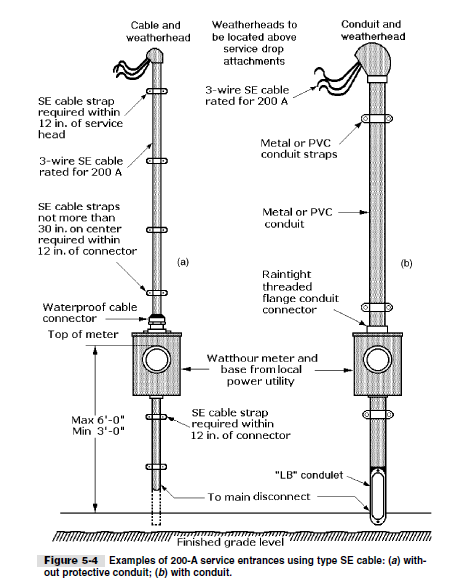My question is regarding service entrance cables. I’m noticing that a lot of houses in my area have the cable going to a spot on the side of the house, under the eaves. Does this type of connection still require a drip loop and goose neck? Also, the course mentions the cable need no be in conduit if it is type SE cable. How can you tell if it is or not? Finally, how do you report this if you were to find a lack of drip loop or gooseneck on a service mast? Is that for the utility company to fix or a licensed electrical contractor? Thanks!
230.54 Overhead Service Locations.
(A) Service Head. Service raceways shall be equipped with a service head at the point of connection to service-drop conductors. The service head shall comply with the requirement for fittings in 314.15.
(B) Service Cable Equipped with Service Head or Gooseneck. Service cables shall be equipped with a service head. The service head shall comply with the requirement for fittings in 314.15.
Exception: Type SE cable shall be permitted to be formed in a gooseneck and taped with a self-sealing weather-resistant thermoplastic.
© Service Heads and Goosenecks Above Service-Drop Attachment. Service heads and goosenecks in service-entrance cables shall be located above the point of attachment of the service-drop conductors to the building or other structure.
Exception: Where it is impracticable to locate the service head or gooseneck above the point of attachment, the service head or gooseneck location shall be permitted not farther than 600 mm (24 in.) from the point of attachment.
(D) Secured. Service cables shall be held securely in place.
(E) Separately Bushed Openings. Service heads shall have conductors of different potential brought out through separately bushed openings.
Exception: For jacketed multiconductor service cable without splice.
(F) Drip Loops. Drip loops shall be formed on individual conductors. To prevent the entrance of moisture, service-entrance conductors shall be connected to the service-drop conductors either (1) below the level of the service head or (2) below the level of the termination of the service-entrance cable sheath.
From Drip loop? - InterNACHI Inspection Forum http://www.nachi.org/forum/f19/drip-loop-53094/#ixzz32kwQnclG
Hope that helps bud.
The service head is required to be above the point of attachment for SE cables. Also a drip loop is required.
Not if I was the electrical inspector. ![]()
Glad you feel that way. It was in my report.
How about this one, new service, probably no permit:
https://lh4.googleusercontent.com/l16NT_5ctwWbEJtBZo6TsFJkY_cUtwPn2a-ecjZt5mU=w338-h224-p-no
Most likely not.
Thanks for all the replies. In your report who do you recommend to fix it? Is it the utility company’s issue or an electrician?
You could recommend a “qualified professional” depending on the need.
This is typical, around here (blue = customer’s qualified electrician responsibility and red = utility company responsibility):
http://www.ocalafl.org/uploadedImages/Utility_Services_Redesign/Weather-Head.jpg
Thanks Larry! Is it just me or is this all overwhelming when you’re first starting out?!
You’re welcome. And, as far overwhelming, like anything, it gets easier the more we learn…![]()
One more thing, and I apologize for all the questions, but is the drip loop required even when the SE cable runs down from the point of connection? For example, if the connection is on top of a second story and the SE cable runs down from there to the power line.
Chris C, why would that not pass in your opinion?
IMO the two hot cables are either level, or running uphill (one in back). Though they do run up just a tad when entering weather head, to me with enough accelerated force the water could still easily enter and run down the cables.
It’s kind of a border line call.
Great diagrams Larry, I copied them, hope it’s OK
good pics also
Sorry Chris, I was referring to this one
https://lh4.googleusercontent.com/l16NT_5ctwWbEJtBZo6TsFJkY_cUtwPn2a-ecjZt5mU=w338-h224-p-no
Curious Jim as to what you think of that one? IMO it’s not a drip loop but as mentioned the term is not defined by the NEC.


